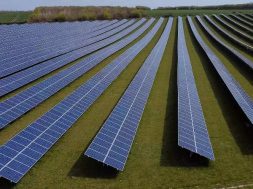Silicon solar cell of ISFH yields 25% efficiency with passivating POLO contacts
The Lower Saxony Institute for Solar Energy Research Hamelin (ISFH), an affiliated institute of the “Leibniz Universität Hannover” in collaboration with the Institute of Electronic Materials and Devices (MBE) of the “Leibniz Universität Hannover” achieved a solar cell efficiency of 25 %. This result was confirmed by DAkkS-accredited independent calibration laboratory ISFH CalTeC and presented at the Asian conference PVSEC-26 in Singapore. This high efficiency was achieved with passivating POLO contacts for both polarities, which avoids the otherwise high recombination beneath the metal contacts. POLO stands for “poly-Si on oxide“. The contacts consist of a thin silicon oxide and a doped polycrystalline silicon layer.
The recombination is reduced by the POLO contacts to an extend enabling a high open circuit voltage of 723 mV. Both polarities of the POLO layers are located at the rear side of the solar cell, avoiding the shading of the front side by metal fingers and reducing the parasitic absorption in the poly-Si. The result was achieved on a cell area of 3.97 cm2 (designated area). In the ongoing project the efficiency shall be further increased and complex process steps shall be substituted by industrial relevant processes. The work was achieved within a joint project (contract No. 0325827A), funded by the German Federal Ministry for Economic Affairs and Energy (BMWi), where ISFH cooperates with MBE and the Fraunhofer-Institut für Solare Energiesysteme (ISE).
Related posts:
- ‘India must serve local demand to win WTO solar dispute’
- Aurora Solar Technologies extends advanced cell R&D collaboration with SERIS in Singapore
- Meyer Burger enters into Preferred Partnership Agreement with Mondragon Assembly to collaborate on module equipment development and outsource the manufacture of its SWCT™ equipment
- Alta Devices Launches New Generation Solar Cell Designed to Empower Autonomy for UAVs and Other Vehicles












